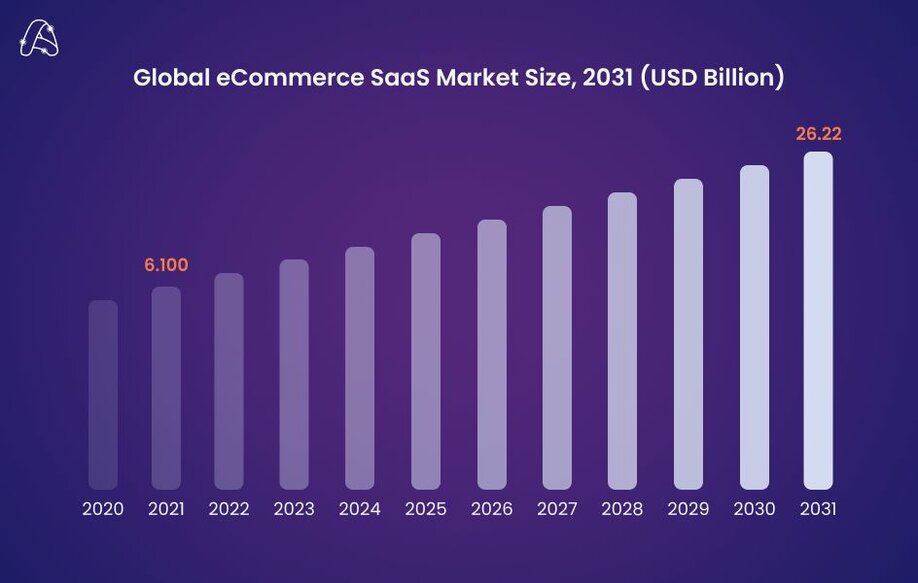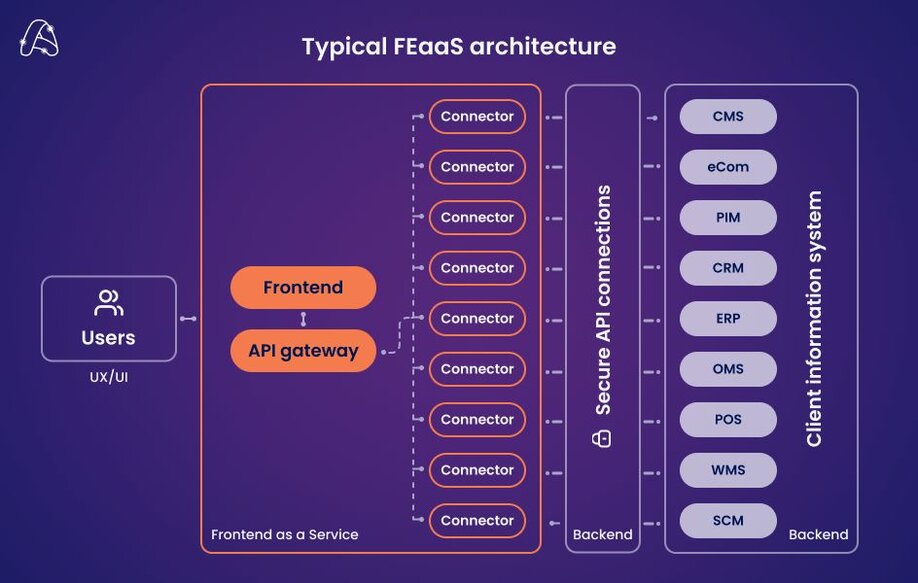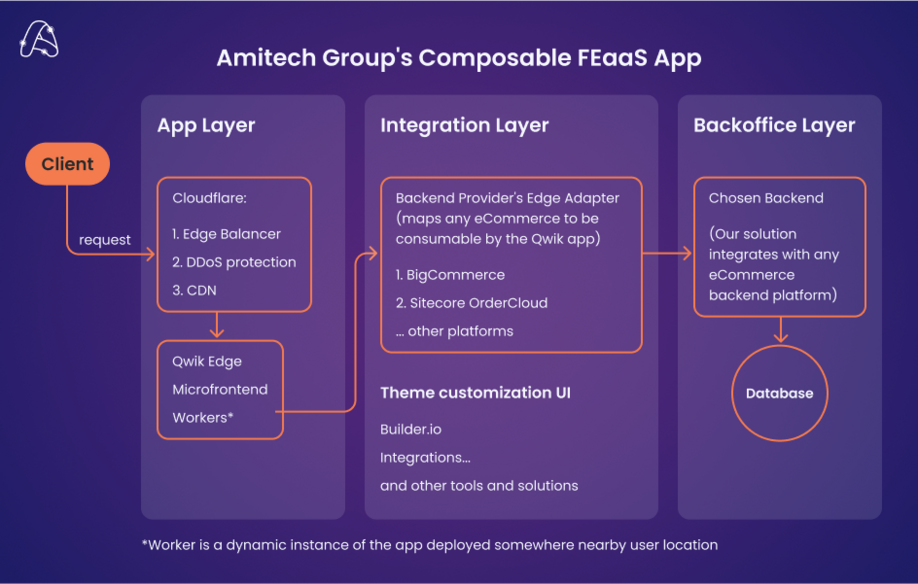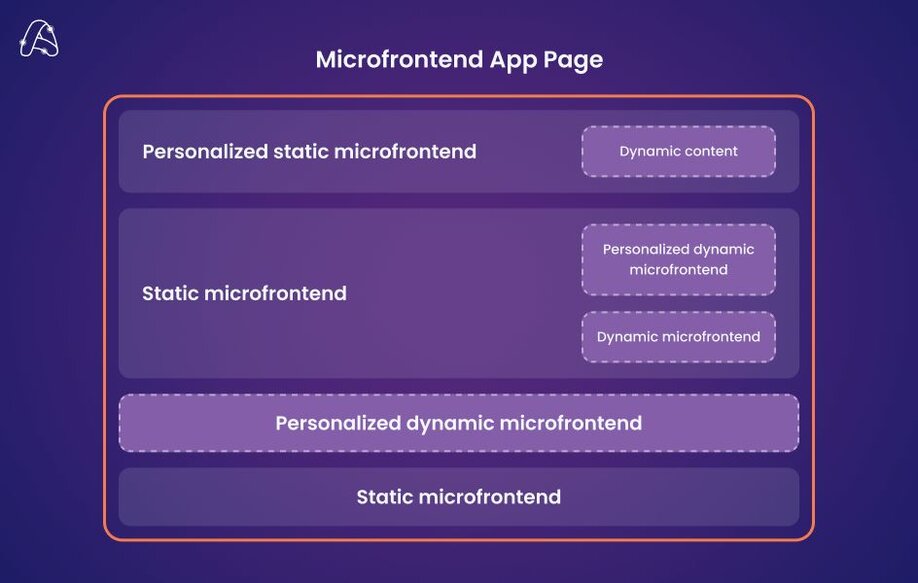Blog post
Expert advice
🕒 15 min
Does the Frontend As a Service Have Your Back? Atlas Shrugged
Unraveling FEaaS (or FaaS, if you will) as an online business acceleration strategy, and all things eCommerce

- All hands on deck, all eyes on the front
- Okay. So what’s the big deal about this FEaaS, FaaS, or whatever?
- But why reinvent the wheel? Anything wrong with classic web development?
- Fine. Still don’t buy it. Got more USPs?
- Enough with sugar coating. Trick or treat?
- Right. DYOR is the absolute king
- Point-of-arrival guesswork
- Bonus. A word before you go
Welcome one and all to our tech deconstruction sessions! Treat yourself to a balanced mixture of ripe analysis and creamy showmanship topping, ideal with a cappuccino or on its own.
Your attention, a chef's specialty. Today, we’re going to make sense of a tech approach that we at Amitech Group are currently busy embracing and even building products upon. It’s Frontend as a Service (FEaaS) we’re talking about.

FEAAS IN TODAY's COMMERCE ECOSYSTEM
All hands on deck, all eyes on the front
First thing, why the interest? What makes us whoosh into the eCommerce FEaaS battlefield headfirst, with guns blazing? Many reasons. Mainly our blossoming composable frontend architecture development and MACH commerce expertise. But for starters, let us dangle some eye-opening stats.
Every living soul advocating FEaaS remembers to mention the Gartner forecast that by 2023, -aaS approaches will run half of all new commerce functionalities. Indeed, that’s a bell you don’t unring. But does the prediction live up to the real situation?
Let’s see. Obviously, the exact figures are hardly calculable, but if anything, Statista says, from 2023 to 2024, the estimated SaaS market will grow from $197B to $232B. A decent rise, huh?
Zooming in closer, we see more forecasts anticipating a boom in the global eCommerce SaaS market, from $6.1B in 2021 to $26.22B by 2031 at a CAGR (compound annual growth rate) of 15.52%.

Forecast credit
But hey, forget the flashy numbers. As industry insiders (some boasting 15 years in eCommerce, give or take), our team feels every change in the wind right in our bones. Especially provided activities like analyzing client preferences year over year, making collaborative decisions with partners, visiting places.
Specifically, this April, we went to BigSummit EMEA, a giant eCommerce get-together thrown by BigCommerce to share what’s huge within the landscape. Long story short, trends are that we’re clearly at a point where the avant scene is taken by composable, backend-agnostic, API-first cloud solutions and MACH architectures, which is exactly what Frontend as a Service is.
Add to this yet another prediction Gartner made this year. It goes that by 2026, each of the major 20 SaaS and cloud providers will come up with component marketplaces enabling composability. Thus, the analysts emphasize it’s a must for tech vendors to ensure composable software architecture support as they reboot their offerings.
Get the picture? Meaning, we’re beyond serious about further moving the needle with our headless storefront undertaking up until it’s the talk of the town.
WHY FEAAS IS A GAME CHANGER IN WEB DEVELOPMENT
Okay. So what’s the big deal about this FEaaS, FaaS, or whatever?
In a nutshell, for online businesses that adopt composable, or headless, FEaaS is all about:
- Faster, times faster market launch
- Better page performance
- Ultimate agility for business growth and innovation
- Customizability to introduce one-to-one personalization, instantly and easily
The thing is, now that the Headless Almighty has ballooned over the entire eCommerce vertical, the storefront is everything. And yes, vendors are reactively elbowing their way to introduce Frontend as a Service, in numbers. Which is, actually, for the better, as the industry gets a powerful impulse while granting the end user with never-before-seen experiences.
About the insides of FEaaS. Technically, the approach simply implies building the frontend as an autonomous, decoupled app living in the cloud. To underpin their solutions with the required functionality, engineers employ APIs and external tools based on business specific needs.


“Take, say, our FEaaS-enabled platform. Under the hood, it now comprises ten apps, each responsible for a particular layer. The microfrontend architecture enables combining the apps in a way to factor in the client’s needs and preferences to their fullest, from backend and business feature choices to the UI settings in all varieties.
Importantly, with all the freedom to ultimately personalize the user experience, there’s no risk to damage the app performance.”


Composable frontend scheme

Microfrontend app page scheme
TRADITIONAL STOREFRONT VS. FEAAS
But why reinvent the wheel? Anything wrong with classic web development?
Well, traditional web development still has its moments. It’s just that decoupling is a key to modularity, which, say, Gartner believes enables 80% faster integration of new functionality. Even more, the auditors think monolithic software in commerce is a thing of the past, and what we are witnessing now is a paradigm shift towards orchestrated architecture, with AI agents driving it.
Just picture this. By building and launching backend functions independently of the frontend, one can devise exclusive, unhindered customer journeys without wrecking web performance. Plus, make a giant leap through the competition.
While monolithic eCommerce platforms are technically (and correspondingly functionally) limited, composable ones are designed to be scalable by default. Our point being, whatever storage and server power you need to occasionally ramp up your services, FEaaS ensures you have it via cloud APIs and microservices. Sheer beauty.
KEY USPs OF FEAAS YOU NEED TO KNOW
Fine. Still don’t buy it. Got more USPs?
By all means, making you buy it isn’t our endgame. At the very best, it’s to suggest checking out our FEaaS-based Composable Commerce Accelerator. See how open we are? Anyways, if you own a small or growing eCommerce business you’re aching to instantly scale, FEaaS is an eligible option. Primarily because whenever the market changes, you are flexible enough to respond, fast.
And then let’s face it, cutting the engineering costs is top of the list. Say, you’ve taken the -aaS route. Then you can choose a pay-as-you-go provider who charges exclusively for the components you need. Meaning, no shelling out for a boatload of excessive tools a monolith often comes up with. Fair investment, right?

Counting the development savings
Again, consistent scalability and future-proof commerce ecosystem.
Imagine some of your products going viral, making the traffic break through the ceiling. Could cost you a fortune. If it weren’t for FEaaS, you’d be toast. Happily, these fears won’t keep you awake at night anymore. No crystal ball, no nothing—you’re equipped to face business bombshells lurking up every corner.
Joining the upsides list, lower overhead, and higher adaptability.
First, building a website upon FEaaS is times faster than agonizing over a monolithic solution. We talk hours, or in the case of our Composable Storefront Accelerator, minutes,—that fast. All the more so, you don’t have to hire a full house of gloomy techies to do the drill. And neither of the changes within the features you happen to make can ruin the entire ecosystem as the case may be with monolithic apps.
Also critical, jaw-dropping user experience. As you opt for FEaaS frameworks, you enable:
- Responsive design
- Omnichannel journey
- Elegant cross-platformity
- Happy users and tight retention
In this regard, you’ll also appreciate the mature personalization and customization that FEaaS brings in. These are, by the way, among the strongest sides of our branded FEaaS solution built within MACH principles. With ready-made templates and features, you have all the time in the world to play with a gazillion ideas for your storefront.
Last but not least, support services. While testing new tools, chances are something goes to waste. Bummer. But wait, this, as a rule, doesn’t concern FEaaS. Phew! Once you invest in the service, your success is also the provider’s responsibility, so make sure the contract includes tech support. Ours does.
BENEFITS OF ADOPTING FEAAS
Enough with sugar coating. Trick or treat?
Really, the good vibes thing aside, is the FEaaS your path? Why fix an app that’s not broken? Let’s see what our Lead Architect suggests.

“Thinking of business cases where FEaaS doesn’t seem an ideal choice, I’d bring up a couple of typical scenarios:
Case 1
Say, you have a project with a long story to it. The situation is that building an FEaaS-based app from scratch isn’t an option, as there are tons of functionality in place.
Looks like all that’s left is to partly refactor your solution while decoupling some of its apps. So, in fact, you’re on your way to adopting composable architecture, where FEaaS might well fit in.
In other words, you rebuild exclusively the page that you think is crucial to be well-optimized for excellent performance. Or else, rebuild its particular part and move it to a more agile app.
Case 2
Chances are that FEaaS doesn’t meet your business requirements in full. Then you just opt for a more technically developed solution. Whatever immutable it is, its solid functionality is highly likely to suit you better.
This may pretty be a winning survival tactic for you in the short to medium term. Yet, as soon as you approach the point where you prioritize scaling, you’d better consider FEaaS.”

And now, we guess, you might already be thinking of choosing a suitable storefront provider. Well, we wish we could suggest one, but we don’t want to. Kidding.
Even though we hate being sandwiched between other vendors stepping on our toes, and burning to steal the show ourselves, none of the FEaaS platforms is a silver bullet, hand to heart. They all greatly differ under the hood.
Anyways, we believe you’re well aware that as you plan to contract a vendor, you should bear in mind:
- Traffic and cost expectations
- Scaling demands
- Specifics of your server operations
With that said, below we’re going to come up with a thing as old as the Book of Genesis…
CHOOSING THE BEST FEAAS SOLUTION
Right. DYOR is the absolute king
Boring yet as simple as that. Especially while searching for an FEaaS to use as a platform for a brand-new app, at the very least, our expert recommends paying attention to the following considerations:
- Performance in the production environment takes special notice. Once the platform is live, it must run like clockwork.
- Code flexibility and scalability. Avoid overly rigid code. Ideally, bringing in changes and implementing new features shouldn’t take shotgun surgery. That is, swapping bits of code quickly and easily must be your basic right, not a privilege.
- A convenient development environment means the world. Obviously, there isn’t a one-size-fits-all package, so closely check it against your preferences.
- Technical documentation. There should be a detailed description of the product’s architecture and functionality. Make sure the service includes what you really need.
- Provider’s expertise in programming languages and frameworks. Better be proven firsthand knowledge so you can rely on their team during further development.
These are by far the most critical points when it comes to building an FEaaS solution from the ground up. But we’d also suggest going further with these:
- Niche expertise. It’s good to have someone who is well up in your vertical. Say, our specialties are eCommerce and foodservice, so be our guest if those are relevant to you.
- Vendor lock-in risks. Beware of getting stuck with an overcharger. Once you build your solution all around a single service, chances are it would be challenging to leave whenever it updates and hikes the prices. That’s because switching providers takes painful and costly rebuilds on your side.
- Costs, again in this regard. Providers charge creatively. Some are more affordable than a full-time engineer, others offer highly specialized services that cost premium, yet cover your needs to perfection. Plus, as your business scales, some small print rates may well pop up. While you’re the boss, take care to learn the pricing details.
- Security and data privacy. Largely Captain Obvious, but still. Before entrusting an external provider with your data storage and processing, find out if the service complies with security regulations and uses decent encryption.

“Yet, no matter the provider, you should take extra care to minimize the data leakage risks. In terms of security, restricting server access helps a lot. Take, say, Cloudflare and Netlify. Both handle the user-server communication via APIs or provider UIs. Thus, they enable greater security compared to AWS where one can interact with the server much closer.”

- Q&A with the support team. Ask what bothers you most. Typically, it’s things like tech compatibility. Meaning, normally, the integration shouldn’t become a supermassive headache taking the rescue squad of wizard engineers.
- Testimonials, references. Given it’s a long-standing commitment, check out as much public data as possible before reaching out. Vet the provider’s track record, and scan their business profiles for life signals and overall maturity.
- Trial check. If available (big “IF”), that’s your safe bet to take the service for a spin and uncover the bottlenecks straight off in a closed environment.
- Customization. The platform should enable you to adapt the display to your brand books or modify whatever you prefer. If not, might be a smoke signal—you don’t want the user experience butchered, right?
MAKING FRONTEND DEVELOPMENT MORE PREDICTABLE
Point-of-arrival guesswork
Pardon the spherical cow-level judgment, but from what we see, looks like it’s the end of the tightly coupled systems world as we know it. Working from the assumption that the above mentioned forecasts are close, you know the odds in the microservices architecture vs. monolithic clinch.
Still, this isn’t to say the decoupled Frontend as a Service is a universal Atlas-league heavy-lifter able to juggle towers of features and loads of traffic while making a beauty queen out of your bulky website,—far from it. We’re afraid, even Caesar would blast, “Okay, multitasking is my thing, but shouldn’t there be an app for that?!

Ideating on an Everything App. Before you know it’s even a thing
The good news is, as we’ve spotted the trend early on, you have a certain edge to sleep on the idea before you decide. That is, give it your best forward-thinking and test a couple of prospective composable FEaaSs against your infrastructure, right away.
Yeah, we imagine, of all suggestions, there’s nothing like business agility that can bore you to death. Whatever. Today, it’s either:
- Choose a composability strategy that sits best with you, quit nestling around a seasoned aging architecture, and attain robust tech flexibility in the long run.
- Brightside the tectonic shift, idly pinning hopes on the wind's change. Spoiler alert. A painful digital transformation in some couple of years is highly likely.
- You name it. Better be something safe and decisive.
FINAL THOUGHTS: WHY FEAAS COULD BE YOUR BEST INVESTMENT
Bonus. A word before you go
Now look at us! We are done with the checklist and we got you the idea of what the FEaaS is. Let’s see, we still have something up our sleeve that our analysts think is promising to be big in eCommerce any time soon, or emerging right now.
- As Big Data analytics expands, FEaaS tech providers tend to tie it together with AI. We, for one, are about to jump on the bandwagon as well (currently planning to extend our Composable Accelerator functionality with AI-powered frontend personalization).
- Out-of-the-box accessibility. Aligning your content and UX with regulations never gets old, so take care to do it by default and rule out penalties.
- Ultimate interactivity. The drop-off rate nightmare is forever, so we’re to keep on bending over backward to retain users. Say, we opt for embedded guided shopping. Might also work out well for you. Okay, dropping the elevator pitch.
And that’s a wrap for today! Jumping to goodbyes, we’d love to add that whenever you decide to step into composable eCommerce or just resolve some mind-scratching tech unknowns, we’ll be there for you in this delightful mission. Anything in between atom splitting and nailing the planet’s existential dilemmas—come on in. Leave a quick line here.
Now, time for a mic drop. Remember to subscribe to our LinkedIn to see these sharp tech speculations on a regular basis. Pretty please, with a cherry on top.
Stay involved, check back for more insights, we’ll have many soon!
Last updated: January 15, 2025
About the authors

Has wizardly powers to magically bring in web and mobile platforms, thus breaking heavy eCommerce spells.

Democratizes those royally sophisticated tech phenomena by means of concise copy and occasional wit.
- All hands on deck, all eyes on the front
- Okay. So what’s the big deal about this FEaaS, FaaS, or whatever?
- But why reinvent the wheel? Anything wrong with classic web development?
- Fine. Still don’t buy it. Got more USPs?
- Enough with sugar coating. Trick or treat?
- Right. DYOR is the absolute king
- Point-of-arrival guesswork
- Bonus. A word before you go

Explore our Composable B2B/B2C Storefront
Go

Keep track on the latest trends in web
Let’s nail another market-shaking project together! While you are thinking, check out our latest ones.